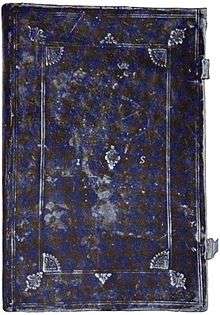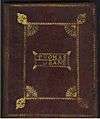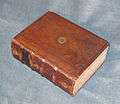John Ratcliff (bookbinder)
John Ratcliff (or Ratcliffe) of the seventeenth century is the first identifiable bookbinder in America, known for binding Eliot's Indian Bible in 1663.[3][4][5][6][7] Ratcliff, who came from London, England, worked as a bookbinder in Boston, Massachusetts for about twenty years, from approximately 1662–1682.[8][9]
John Ratcliff | |
|---|---|
| Born | England |
| Resting place | England |
| Nationality | English |
| Occupation | bookbinder |
| Known for | binding books in America |
| Spouse(s) | Alice[1] |
| Children | John (1664), Thomas (1666), Elizabeth (1669)[2] |
Biography and career
Ratcliff, an experienced London bookbinder,[10] was sent from England sometime between 1661 and 1663 for the purpose of binding copies of Eliot's Indian Bible.[4][11] He moved to America with his wife and family,[12] and lived and worked in Boston for about 20 years.[13][14][15] Sometime around 1682, he left America and went back to England.[9] According to historian Thomas James Holmes, Ratcliff may have returned to England because he was facing competition from younger bookbinders such as Edmund Ranger, who displayed superior workmanship.[9]
At the beginning of Ratcliff's career, he did plain bookbinding using leather from domestic sheep and calves.[16] He decorated the covers with fashions of blind tooling typical of the time period.[16] Later Englishman Ratcliff departed from the normal bookbinding practices and used higher quality and more sophisticated methods, including pasteboard covers instead of wooden boards, and imported Morocco leather instead of domestic leather.[16] He also used marbled end papers instead of plain end papers and did gold tooling instead of blind tooling.[16] The work of typical American colonial bookbinders was crude when compared to Ratcliff's.[17]
Ratcliff spent most of his working career doing bookbinding.[5] However, he also sold a few publications. One publication, printed for Ratcliff in Boston in 1682, was "Fast Sermon at Weathersfield." This 1678 sermon was written by Joseph Rowlandson of Lancaster, Massachusetts. Another publication, also printed in Boston in 1682 was, "A Poem dedicated to the Memory of the Reverend and Excellent Mr. Urian Oakes, the late Pastor to Christ's Flock, and President of Harvard Colledge in Cambridge" who died in 1681 at age fifty. Cotton Mather wrote the poem when he was nineteen years old as his first published work.[1]
Books bound by Ratcliff
Indian Bible
Ratcliff of Boston, Massachusetts bound 200 of the 1500 copies of Eliot's Indian Bible in 1663 for influential noblemen and higher ranking church dignitaries.[18] The bindings were made from sheep-skin.[19] Historical records note that in 1664, Ratcliff complained in a petition to the Commissioners of the United Colonies that he was paid too little for binding Eliot's Indian Bible.[19][20] Ratcliff was being paid two shillings and six pence per copy by Hezekiah Usher and had to supply the covers, clasps, glue, and thread himself.[1] He said that he had to pay 18 shillings for book binding accessories (i.e. thread, glue, pasteboard, clasps) that cost only four shillings in England.[19] Each Bible copy took a day's labour to bind.[19] He told the Commissioners that the lowest price he could bind Eliot's Indian Bible for was three shillings four pence a book, because of the high price he had to pay for the English book binding accessories.[3] In comparison, Samuel Gellibrand, a London bookbinder, was paid ten shillings a copy for binding 20 copies of the Indian Bible that was sent to him in England for binding.[21] This was about four times what Ratcliff was being paid to do the same work.[21]
- The Eliot Indian Bible Mamusse Wunneetupanatamwe Up-Biblum God. The printers were Samuel Green and Marmaduke Johnson of Cambridge, Massachusetts.
- This copy bound by Ratcliff in 1663 is held at The Rosenbach Museum & Library
The Book of the General Laws and Liberties Concerning the Inhabitants of the Massachusetts

bound by John Ratcliffe in 1676
The General Laws and Liberties of the Massachusetts Colony Revised and Reprinted by Order of the General Court were bound around 1676. It was printed in 1672 by Samuel Green for the bookseller Hezekiah Usher of Boston, Massachusetts. The book is a folio 6 inches by 10 inches. The binding was made from calfskin. The color is a deep tone mellow brown, comparable to mahogany. The cover has lines and tools in blank, developing a darker brown than the cover.[22]
The edges of the front cover board covered in calfskin consist of two lines. Within these two line borders there is a marked out panel of two lines. On the corners of this panel is a flourish of tooling.[22] This tooling is a center flower with a fan-shaped tool within the corner. A small flower cluster goes outwards from the edge corners of the cover towards the center. At the upper and lower ends of the main cover halfway between the outer corners is an impression of a triangle of three buds. In the dead center of the cover is an impression of the small flower cluster as used on the outer edge corners. There is a "J" gold initial on the left side of this center image and a "S" gold initial on the right side of the center image, perhaps for the name John Sherman.[22] Sherman was the representative to the General Court of the Massachusetts Colony in 1651, 1653, 1663 and 1680.[23]
The folds of the sections were normally sewn together per the custom of the time. This book did not follow this custom however. The body of the book was cut with four small eye holes through the sides along its back margins. Through these holes were threaded four rawhide strings to hold the book together tightly with the cover boards which also had the four eye holes. The cover boards were even with the edges of the paper in the book.[22]
The American Antiquarian Society has in their possession a book copy of these Massachusetts laws bound by Ratcliff. It is speculated that the reason the leather covers have held up well for over 300 years is that the leather was treated with sumach as a tanning agent, even though the calfskin has become hard as old vellum. The front of the book covers were originally furnished with two clasps for closing the book. The upper clasp for closing the book is missing on the Antiquarian copy. The lower one is still there and it has a simple design on it.[22]
Other bindings by Ratcliff
Other book bindings credited to Ratcliff as his work are:


 Samuel Sewall's Book, 29 December 1677.[25]
Samuel Sewall's Book, 29 December 1677.[25]
- "A Collection of Tracts"[25]
Increase Mather 1670–80
References
- Littlefield 1900, p. 95.
- Colonial Society of Massachusetts 1923, p. 65, v.24.
- Kane, Joseph (1997). Famous First Facts, A Record of First Happenings, Discoveries, and Inventions in American History (5th ed.). H.W. Wilson Company. p. 65, item 1731. ISBN 0-8242-0930-3.
The first bookbinder was John Ratliffe of Massachusetts, who in 1663 was commissioned to bind missionary John Eliot's Algonkian translation of the Bible. His job was to "take care of the binding of 200 of them strongly and as speedily as may bee with leather, or as may bee most serviceable for the Indians." On August 30, 1664, he sent a letter to the commissioners of New England stating that he was not well satisfied with the fees paid him for binding, and that three shillings four pence was the lowest price at which he could bind the books.
- "Early American Bookbinding in Brigham Young University's Special Collections". Harold B. Lee Library – ScholarsArchive. Brigham Young University. 2012. Archived from the original on 3 September 2014. Retrieved 2 September 2013.
- Lawrence C. Wroth (2013). "The colonial printer (1931)". OpenLibrary. Internet Archive. Retrieved 2 September 2013.
- Ellen Shaffer (1956). "Portrait of a Philadelphia Collector" (PDF). The Free Library of Philadelphia. Retrieved 2 September 2013.
- Bodian 1996, p. 14 With this binding assignment, Ratliffe became the first bookbinder of record in British North America..
- Tebbel 1972, p. 43.
- Holmes 1929, p. 14.
- Thorsen 1973, p. 24, v 24–25 John Ratcliffe was brought from London to bind John Eliot's translation of the Bible for the American Indians in 1663.
- "Ratcliff, John". Bookbinding and the Conservation of books / A Dictionary of Descriptive Terminology. Conservation OnLine / Resources for Conservation Professionals. 28 August 2013. Retrieved 2 September 2013.
- Wroth 1938, p. 192.
- Maser 1983, p. 13.
- Holmes 1929, p. 32.
- Wroth 1964, p. xi.
- Diehl 1979, p. 154.
- Diehl 1979, p. 155.
- Wolf 2009, p. 113.
- Ringwalt 1871, p. 155.
- Holmes 1929, p. 5.
- Holmes 1929, p. 3.
- Holmes 1929, p. 17.
- Darrin, Darrin; Lythgoe (2001–2013). "Captain John Sherman". The Next Generation of Genealogy Sitebuilding. Retrieved 2 September 2013.
- "Nathaniel Morton's New-England Memoriall (Cambridge, Mass., 1669)". americanantiquarian.org. American Antiquarian Society. 2011. Archived from the original on 3 March 2016. Retrieved 31 August 2013.
- Holmes 1929, p. 15.
- Holmes 1929, p. 9.
Bibliography
- Bodian, Nat G. (1996). The Joy of Publishing. Open Horizons. ISBN 978-0-912411-47-7.CS1 maint: ref=harv (link)
- Colonial Society of Massachusetts (1923). Transactions. The Society.CS1 maint: ref=harv (link)
- Diehl, Edith (1979). Bookbinding, Its Background and Technique. Hacker Art Books. ISBN 978-0-486-15614-9.CS1 maint: ref=harv (link)
- Holmes, Thomas James (1929). The Bookbindings of John Ratcliff and Edmund Ranger: Seventeenth Century Boston Bookbinders (PDF). Proceedings of the American Antiquarian Society 38(2): 31-50. 1929.CS1 maint: ref=harv (link)
- Littlefield, George Emery (1900). Early Boston booksellers 1642–1711. The Club of odd volumes.CS1 maint: ref=harv (link)
- Maser, Frederick E. (December 1983). Bookbinding in America, 1680–1910: from the collection of Frederick E. Maser. Bryn Mawr College Library.CS1 maint: ref=harv (link)
- Ringwalt, John Luther (1871). American Encyclopædia of Printing. Menamin & Rinwalt. p. 155.CS1 maint: ref=harv (link)
- Tebbel, John William (1972). A History of Book Publishing in the United States: The creation of an industry, 1630–1865. R. R. Bowker Company. ISBN 978-0-8352-0489-7.CS1 maint: ref=harv (link)
- Thorsen, W.B. (1973). The American Book Collector.CS1 maint: ref=harv (link)
- Wolf, Edwin (December 2009). Todd Lecture Series. Royal Irish Academy. ISBN 978-1-151-45471-3.CS1 maint: ref=harv (link)
- Wroth, Lawrence Counselman (1938). The colonial printer. The Southworth-Anthoensen press.CS1 maint: ref=harv (link)
- Wroth, Lawrence C. (1964). The Colonial Printer. Courier Dover Publications. ISBN 978-0-486-28294-7.CS1 maint: ref=harv (link)
External links
- Holmes, Thomas James. Additional notes on Ratcliff and Ranger bindings (PDF). Proceedings of the American Antiquarian Society 39(2): 291-306. 1929.





